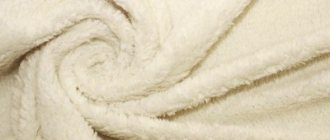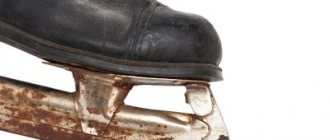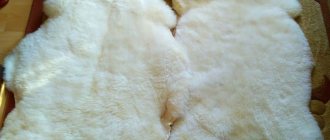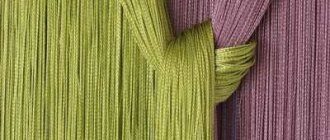Raw sheep should never be immediately used to make a planned product. First you need to clean it. Raw wool always contains debris. In addition, it is necessary to get rid of the sheep odor. Naturally, working with unclean material is unpleasant, to say the least. However, washing and cleaning raw wool is quite labor-intensive and requires some knowledge. After carefully reading this article, you will learn how to wash sheep's wool at home.
Before washing sheep wool, prepare everything you need:
- You can wash the raw material with a special washing powder for wool products. You can also use animal washes. Regular washing powder should not be used because the wool will be difficult to rinse.
- Grease-dissolving agents or dishwashing liquids work well to remove grease from fur.
- You will need a washing container, a colander and a wire rack. A cat litter box with a grate, familiar to many, would work well. The grate will be useful to you in order to more conveniently manage the wool - lowering and removing it from the water. It is not very pleasant to take out unwashed wool with your hands and, in addition, the grid will help you conveniently collect the wool when you change the water. It should be noted that you will have to change the water more than once.
- To avoid unpleasant odor from wool, you can stock up on a respirator.
- To dry the raw material, use a mesh or gauze.
- You will also need a comb, preferably a wooden one.
How to wash sheep's wool at home - step-by-step instructions
What you will need:
- hot water;
- sink, large bathtub or top-loading washing machine;
- several mesh laundry bags;
- soap dish;
- rubber gloves (dishwashing gloves);
- sweater dryer.
Instructions
Step one. Fill the sink with hot water and dissolve laundry soap. The amount of soap depends on your canvas.
Step two. Wearing rubber gloves to protect your hands from hot water and dirt, carefully place the mesh bag of wool into the water. Keep the bags under water until the contents are wet.
Step three. Leave for thirty minutes - the water should cool slightly, but not completely. If you leave wool in water that gets cold, the lanolin will simply settle on the fiber, and this will not lead to anything good.
Step four. Drain the dirty water, add more hot water and add soap again. Do not allow water to get directly onto the fur! If you are using a sink, you can move the bags to the side.
Step five. Place the bags back into the water and leave them for half an hour. Depending on how dirty the canvas was, you can repeat steps three and four as many times as needed.
Step six. Rinse thoroughly in warm water.
Step seven . Gently press the bags against the side or bottom of the sink to release most of the water. Do not roll or twist the wool!
Step eight. To dry the wool, lay it out on a vertical surface - this may take several days depending on the weather and humidity.
How to remove difficult stains?
If stains appear on the product, but in general it does not need to be washed, you can remove them using safe means at hand, including:
- Laundry soap solution . It is grated and diluted with water until a thick paste is obtained. To enhance the effect, you can add a small amount of shampoo. The resulting composition is applied to the stain and left for 30 minutes.
- Salt, soda and liquid soap . All components are mixed in equal proportions and applied to the stain for 1 hour.
- Ammonia . A cotton pad is moistened with it and the stain is treated until it disappears completely.
- Turpentine. It is used by analogy with ammonia.
- Lemon juice . Use it only to remove stains from white or light-colored items. The juice is applied to the stain and left to act for 30 minutes.
Regardless of which composition was chosen for washing, after exposure it must be washed off with clean water. Do not leave the substance on the fur.
LiveInternetLiveInternet
—Categories
- February 14 (31)
- February 23 (7)
- Aquarium (1)
- Aromatherapy (0)
- Library (4)
- Bonuses (2)
- Be healthy (26)
- Crochet (158)
- Accessories (11)
- Children's clothing (12)
- For home (37)
- Toys (39)
- Motives (27)
- Clothes (5)
- Booties (4)
- Equipment (6)
- Patterns (4)
- Knitting (19)
- Details (1)
- Toys (3)
- For kids (2)
- Clothes (5)
- Booties (5)
- Patterns (1)
- Dacha (6)
- Vegetable garden (2)
- Garden decor (1)
- Diary (1)
- House (18)
- Blanks (17)
- Jam (14)
- Ideas (5)
- Interior (2)
- Calendar (1)
- Computer (2)
- Cutting and sewing (14)
- Children's clothing (7)
- Toys (3)
- Maslenitsa (20)
- Massage (2)
- Music (6)
- New Year (55)
- Numerology (1)
- Rituals (14)
- Diary design (1)
- Easter (35)
- Useful tips (10)
- Travel (3)
- Recipes (541)
- Melon (5)
- Watermelon (3)
- Lamb (8)
- Pancakes/Pancakes (29)
- Main courses (2)
- Baking (10)
- Mushrooms (7)
- Desserts (32)
- Blanks (3)
- Snacks (33)
- Zucchini (5)
- Potatoes (7)
- Strawberry (1)
- Candy (32)
- Cream (1)
- Chicken (26)
- Flatbread/Pizza (12)
- Seafood (29)
- Carrots (1)
- Cookies (33)
- Pies (11)
- Tomatoes (1)
- Salads (36)
- Pork (15)
- By-products (14)
- Soups (28)
- Cottage cheese (4)
- Cake/Pie (91)
- Pumpkin (18)
- Minced meat (11)
- Bread (29)
- Apples (5)
- Figure (11)
- Handicrafts (160)
- Beads (8)
- Second life for old things (8)
- Embroidery (1)
- Cross stitch (9)
- Ribbon embroidery (1)
- Decoupage (14)
- Dolls (2)
- Modeling (1)
- Macrame (13)
- Soap making (2)
- Papier-mâché (1)
- Newspaper weaving (26)
- Pillows (6)
- Bags (3)
- Gift Wrapping/Cards (18)
- Garden and vegetable garden (16)
- Beauty salon (43)
- Hair (9)
- Face (13)
- Manicure (10)
- Hairstyles (2)
- Hands (6)
- Self-knowledge (6)
- This and that (4)
- Herbs (22)
- Farm (1)
- Movies (2)
- Photo (1)
- Feng Shui (4)
- Persimmon (3)
- Halloween (20)
- Flowers in the house (16)
—Search by diary
—Subscription by e-mail
— Regular readers
-Statistics
How to wash sheep wool (raw): step-by-step instructions
If you decide to take up handicrafts and have purchased raw sheep wool for your purposes, then do not rush to put it into use right away. First you need to clean and wash it. Unprepared wool still contains the smell of sheep and contains a lot of debris and dust. It’s simply unpleasant to touch, and there’s no question of using it at all. It is not so easy to wash it; if you do it incorrectly, you will simply ruin the sheepskin. First, you should carefully study how to wash sheep’s wool, what products are needed for this, and how to dry it. This is what we will talk about now.
You will need the following wool washing products:
- Detergent for wool products. It is better not to wash with regular powder, as it is difficult to wash out and can destroy the structure of the fibers. As a last resort, you can use regular shampoo or pet wash gel.
- Dishwashing gel or other grease remover.
- Mesh, wire rack, colander and container in which you will wash. The ideal solution is a cat litter box with a grid.
The mesh is necessary to make it easy to lift and lower the wool into the water; it is not advisable to touch it, and it will be inconvenient to collect it when changing the water, which will happen often.
- Respirator. Wet wool has a specific, unpleasant odor, so it is better to cover your nose.
- Gauze or mesh on which the wool strands will dry.
- Hair comb, wooden comb.
Features of wool when washing
Wool is a natural raw material. In general, it is divided into living and dead. The first is sheared from live sheep, the material is characterized by increased softness, wear and durability. Wool, called dead wool, has much worse characteristics because it is obtained from slaughtered animals in slaughterhouses. Before looking for the answer to the question of how to properly wash woolen products, you need to find out what type of material will be processed. Today the following varieties are known:
- camel's wool;
- merino (a special breed of fine-wool sheep that is shorn only at the withers);
- cashmere (down from Tibetan goats);
- mohair (fur from Angora goats);
- Angora (fluff obtained from very fluffy Angora rabbits);
- alpaca (a type of wool obtained from Peruvian llamas).
The labels will help you figure out at what temperature to wash wool. The fact is that natural wool is a very fancy material. In particular, when washing it can:
- deform;
- change color;
- sit down;
- lose natural softness.
Decoding symbols for caring for natural wool products.
Often, washing wool, or more precisely, white items, ends with them turning yellow. In addition, pilling often occurs on washed woolen clothes.
Washing step by step
- Sort through all the sheep's wool. Remove large debris, straw, and grass from it. To make the process go faster, you can take a comb (for example, a comb for cats or dogs) and comb out the sheepskin. Additionally, you can knock out the trash with a stick. This method has been used since ancient times.
- Fill a container with very hot water and dilute the grease removing gel in it. This is a very important stage, since it is impossible to wash sheep’s wool without rinsing off the lanolin. Lanolin is a natural animal fat that is secreted from the skin of sheep and remains on the wool.
- Place the sheep's wool on a wire rack and place it in the prepared water. Lower and raise the screen for 5-10 minutes, change the water, add detergent and lower and raise again. There is no need to stir or wring out the sheep's wool; it is better not to touch it so as not to damage it.
https://www.veseldom.com/wp-content/uploads/2015/02/762-300×200.jpg 300w" title="sheep wool" width="335″ /> - After half an hour of such manipulations, drain the soapy water, rinse under pressure with hot water and add a new one, diluting wool detergent in it. You need to wash in hot water, since at high temperatures the fat wax will dissolve faster, and the wool fibers will not mat.
- Soak the sheepskin for one and a half to two hours, changing the soap solution every half hour. If the water cools faster, change it more often. Temperature shock should not be allowed. It is important to wash the sheepskin in hot water, since of all the various influences exerted on the fibers during washing, the main one is temperature (there is no spinning, friction, or stirring). Hot water will help dissolve the fatty wax that envelops the hairs and prevent the hair from matting. Since the water is changed after half an hour, and it does not have time to cool completely, pouring a fresh soap solution onto the sheepskin does not lead to thermal shock and, therefore, to wool tangling.
- Drain the soap solution one last time and fill with clean hot water. Rinse the wool, again wash only with a net. Change the water. Repeat the procedure until all the dirt and soap solution are washed away.
How to properly clean sheep's wool items
Washing is done by hand and machine. The latter is used only if the product is small and the instructions for it allow machine cleaning. In this case, you must follow the general rules:
- Avoid exposure to aggressive particles.
- Do not rub the product too much or twist it.
- Washing water should not exceed a temperature of 40 °C.
- Avoid prolonged contact with liquids.
Do not leave sheep wool items crumpled after washing. Any product should be straightened before drying.
Wash by hand
Before cleaning the entire product, you need to make sure there are no stains or heavy dirt. Process each of them separately. Also tidy up the fur separately.
When washing by hand, it is recommended to first whisk the detergent into a foam, and then treat the clothes or rug with it. If the mixture is applied directly to the sheepskin, it must be quickly beaten with your hands or a sponge. You can wash off the foam only with warm or cool water, never hot.
After washing, dry the product thoroughly. If hardened areas have formed, they need to be kneaded. The last stage is combing.
Machine washable
In this case, a special mode for wool or delicate washing is used. At the first stage, it is also recommended to check for stains, get rid of them, and then begin machine processing of sheep wool at home.
The spin speed should not exceed 600 rpm. Upon completion of washing, the items are dried, straightened, and combed if necessary.
Useful tips
- Try not to contaminate sheepskin products and wash them as little as possible.
- Wash only in warm water.
- Sheepskin cannot be ironed, only steamed!
- Dry horizontally.
- Do not dry near heaters or in direct sunlight!
- Machine spinning is prohibited!
- Don't fold!
- It is recommended to ventilate the product once a month.
What to do to prevent wool from itching
What to wear with a satin skirt
Safe products and tools
When cleaning manually, it is recommended to use special brushes and sponges. They allow you to comb out dirt, dust, and remove small debris. The choice of tools depends on the goal:
- Stiff brushes deal with stains. They are used only in areas of intense pollution. In other places, the massaging effect of the hands is enough.
- Dirt often accumulates on the surface near pockets, belts, buttons, and in the seam area. Rubber brushes or a stationery eraser are used for cleaning.
- Rubber or regular sponges for washing help to whip up the foam.
Combing the skin is done with hard brushes. It could even be a cat comb or products made from wire.
Safe chemistry
Only special products can be used to clean sheep's wool. Ordinary powders cannot be used, even if they are pre-dissolved. They are difficult to wash off, can damage the surface, and after use the wool becomes dull and loses softness.
You should also avoid preparations containing chlorine. This substance has a destructive effect on wool.
The cleaning agent must be liquid and have gentle properties. A distinctive feature of most preparations suitable for wool is the presence of lanolin as an active ingredient. It ensures the safety of the fibers.
At home, preparations for washing and removing stains are used, for example:
- Henkel . Available in the form of a liquid concentrate that preserves the tenderness and softness of things. Has a pleasant aroma. Easy to rinse.
- Wool Care . Prevents hair from rolling and copes well with cleansing in cold water.
- Sommieres Powder . Designed to remove greasy stains. The product is applied to the contaminated area and left for several hours. Then remove it carefully with a napkin.
- Living Licker Konz. Restores shine, cleanses, gives softness.
- Ultra Finish Milk . Designed for cleaning, eliminating the appearance of sticky fluff, and restoring shine.
- Vanish . The product is mixed with water, then whipped until foamy and applied to the product with a sponge.
- Villi . The domestic product is perfect for hand washing.
In some cases, it is recommended to use regular hair shampoos or gels. But they are intended for a completely different purpose and do not contain the component necessary for cleaning wool, so it is better not to take them.
Along with cleaning products, you can use soft rinses, conditioners, and balms. are used .
Dry cleaning
Trying to “wash” a wool blanket is irrational. Natural sheepskin may lose its appearance and become tough after soaking. It is recommended to use products containing natural sheepskin formulas. In extreme cases, active foam for wool carpets will do. You can purchase a special gel containing lanolin. The sequence of actions is as follows:
- Dissolve the cleaning agent with lanolin in warm water according to the instructions.
- Whisk the solution vigorously until a stable and thick foam forms.
- Apply foam without liquid to the entire surface of the blanket or to contaminated areas. You should remove dirt from the surface with a sponge rather than rubbing it in.
- During drying, the product should be turned over periodically.
Products with exposed wool are cared for as follows: vacuumed, thoroughly dried, ventilated in fresh air to eliminate unpleasant odors. In winter, sheepskin can be cleaned with snow.
How to care for sheepskin items
Regular care will keep the product looking great for a long time. Wool processing takes place according to the following rules:
- If the item is worn in unfavorable conditions or is exposed to precipitation, protective water-repellent agents should be used.
- It is advisable to inspect your items every week to check for any contaminated areas. They must be cleaned immediately, because old stains are more difficult to get rid of.
- Shake out woolen items as often as possible, especially for rugs, blankets, and shoes. This measure will help get rid of surface contamination and dust.
- Use a vacuum cleaner to remove debris.
- Avoid contact with liquid. If the product gets wet, it should be dried in a well-ventilated, warm room. Sheepskin coats and clothes should be hung on hangers. Place blankets and rugs on a horizontal surface. Hair dryers and radiators should not be used for drying.
- Be sure to comb the sheepskin after each cleaning.
- During the initial processing of wool, it is necessary to put in order not only the hide, but also the skin of the product.
- For storage, use covers with a breathable surface made from natural fabrics. It is advisable not to put woolen items in a pile or pile. There should be space between them to allow air to pass through.
An envelope or set made of sheep's wool intended for children requires special care. If the instructions say that it can be machine washed, you need to use the delicate cycle. In this case, special children's wool products are used. If the lining is detachable, the upper part is machine washed and the fur is cleaned by hand.
In winter, sheepskin coats are very popular. They cannot be washed in a machine. Only foam obtained from a detergent is suitable for cleaning. Moreover, if the product gets too wet, it will be damaged.
When caring for items made from sheep wool, it is important to use preventive measures and remove stains as soon as they appear.
Manual processing
When washing wool at home, ask someone to help you, as the weight of the wet item will increase greatly.
Washing a blanket is best done in the bathroom. Wool fibers absorb water well and greatly increase in size. You need to pour a lot of water; if there is not enough water, then all the bedding will be covered with stains and you will have to wash it again.
You should not use hot water, otherwise the canvas may shrink in size. It should be about 30 degrees. The blanket only needs to be soaked for 15 minutes. It is forbidden to rub wool too hard because it quickly pills and loses its shape. You need to wash it very carefully, making smooth movements.
Advice! Rinse several times until the soap components are completely rinsed out. You can’t squeeze it too hard, just squeeze out excess water and spread it on a horizontal surface. When the canvas dries, be sure to shake it vigorously and straighten out the lumps.
How to wash sheep wool (raw): step-by-step instructions
If you decide to take up handicrafts and have purchased raw sheep wool for your purposes, then do not rush to put it into use right away. First you need to clean and wash it. Unprepared wool still contains the smell of sheep and contains a lot of debris and dust. It’s simply unpleasant to touch, and there’s no question of using it at all. It is not so easy to wash it; if you do it incorrectly, you will simply ruin the sheepskin. First, you should carefully study how to wash sheep’s wool, what products are needed for this, and how to dry it. This is what we will talk about now.
Be sure to prepare for this process. Gather all the necessary tools and cleaning supplies. You can’t just wash the raw material in the sink with soap, it will only ruin the material.
You will need the following wool washing products:
- Detergent for wool products. It is better not to wash with regular powder, as it is difficult to wash out and can destroy the structure of the fibers. As a last resort, you can use regular shampoo or pet wash gel.
- Dishwashing gel or other grease remover.
- Mesh, wire rack, colander and container in which you will wash. The ideal solution is a cat litter box with a grid.
The mesh is necessary to make it easy to lift and lower the wool into the water; it is not advisable to touch it, and it will be inconvenient to collect it when changing the water, which will happen often.
- Respirator. Wet wool has a specific, unpleasant odor, so it is better to cover your nose.
- Gauze or mesh on which the wool strands will dry.
- Hair comb, wooden comb.
Washing step by step
- Sort through all the sheep's wool. Remove large debris, straw, and grass from it. To make the process go faster, you can take a comb (for example, a comb for cats or dogs) and comb out the sheepskin. Additionally, you can knock out the trash with a stick. This method has been used since ancient times.
- Fill a container with hot water and dilute the grease removing gel in it. This is a very important stage, since it is impossible to wash sheep’s wool without rinsing off the lanolin. Lanolin is a natural animal fat that is secreted from the skin of sheep and remains on the wool.
- Place the sheep's wool on a wire rack and place it in the prepared water. Lower and raise the screen for 5-10 minutes, change the water, add detergent and lower and raise again. There is no need to stir or wring out the sheep's wool; it is better not to touch it so as not to damage it.
- After half an hour of such manipulations, drain the soapy water, rinse under pressure with hot water and add a new one, diluting wool detergent in it. You need to wash in hot water, since at high temperatures the fat wax will dissolve faster, and the wool fibers will not mat.
- Soak the sheepskin for one and a half to two hours, changing the soap solution every half hour. If the water cools faster, change it more often. Temperature shock should not be allowed.
- Drain the soap solution one last time and fill with clean hot water. Rinse the wool, again wash only with a net. Change the water. Repeat the procedure until all the dirt and soap solution are washed away.
To keep your hair curls from becoming matted, shiny and easy to comb, you can treat them with a balm for oily hair. Gently spread the balm, leave for 20-30 minutes, rinse under running warm water.
- Carefully separate the wool into strands and place them on gauze or mesh to dry. Spread out in an even layer, no more than 1.5 cm thick, otherwise it will not dry well or fall off.
- Dry in a well-ventilated place. Better outdoors in the sun. In apartment conditions, it is allowed to install it near the battery.
With salt without soap
This folk method removes dirt from wool fibers well and preserves their color. Therefore, table salt is used for both white and colored products. The fleece must be cleaned before washing.
Further actions are carried out according to the algorithm:
- Fill a bowl with hot water and soak the material in it. After 20–30 minutes, drain the dirty water and use a colander to get rid of excess moisture.
- Prepare a saline solution in a basin (30 g of table salt per 1 liter of water).
- Dip raw sheep into it and leave for 1.5–2 hours. Then drain the dirty water and repeat the procedure 2-3 times.
- Rinse the wool with plenty of cold water.
Video: Washing, sorting, combing sheep's wool with hand combs
How to wash sheep's wool
Raw sheep should never be immediately used to make a planned product. First you need to clean it. Raw wool always contains debris. In addition, it is necessary to get rid of the sheep odor. Naturally, working with unclean material is unpleasant, to say the least. However, washing and cleaning raw wool is quite labor-intensive and requires some knowledge. After carefully reading this article, you will learn how to wash sheep's wool at home.
Before washing sheep wool, prepare everything you need:
- You can wash the raw material with a special washing powder for wool products. You can also use animal washes. Regular washing powder should not be used because the wool will be difficult to rinse.
- Grease-dissolving agents or dishwashing liquids work well to remove grease from fur.
- You will need a washing container, a colander and a wire rack. A cat litter box with a grate, familiar to many, would work well. The grate will be useful to you in order to more conveniently manage the wool - lowering and removing it from the water. It is not very pleasant to take out unwashed wool with your hands and, in addition, the grid will help you conveniently collect the wool when you change the water. It should be noted that you will have to change the water more than once.
- To avoid unpleasant odor from wool, you can stock up on a respirator.
- To dry the raw material, use a mesh or gauze.
- You will also need a comb, preferably a wooden one.
How to wash sheep's wool: step-by-step instructions
Manually remove any debris from the fur as much as possible. Using a comb will make things go faster. In ancient times, waste was knocked out of wool with a stick.
Dissolve grease remover in hot water to remove lanolin. Lanolin is always present on sheepskin, as it is released directly from the skin of sheep.
- Place the prepared raw cheese on a wire rack and begin lowering and lifting the rack into and out of the water. Repeat this procedure at least ten times, then change the water and lower and raise the wool on the grid again. It is better not to touch wool with your hands, because it is very easy to damage it when washed by hand. Dedicate at least half an hour to this stage.
- Then rinse the wool with running hot water (or under the shower) and make a new solution with wool powder. Wash the wool immediately before the water cools down, otherwise the remaining fat wax will not dissolve. Hot water is also good for the wool itself - its fibers do not mat when washed.
- Next, you should soak the wool. The soaking process itself should last two hours, but the water should be changed as soon as it begins to cool (about every half hour). Try to keep the used and new water at the same temperature - wool does not like temperature changes.
- Washing wool ends with rinsing in clean hot water. For the final rinse, use the rack again. You need to rinse until the dirt and soap solution are completely washed away.
If after washing and rinsing you use a conditioner for oily hair, your hair will be shiny, even, and you will not have any difficulty combing it. The balm should be applied to the fibers for about half an hour, and then rinsed off with running water.
Drying sheep wool
Next, the raw material needs to be dried. The wool is laid out in strands on a grid, gauze or mesh. The layer of wool should be even and not too thick for good drying. You need to dry it in a ventilated area (possibly near a heating radiator). If the weather permits, the wool can be dried outside in the sun.
This is the entire washing process, after which the raw wool is completely ready for further use according to your intentions. The process is quite labor-intensive, but we should not forget that finished woolen items have already been processed before they were purchased, and washing them does not require such effort.
Your further actions depend on what you intend to accomplish from the raw material. Often raw materials are purchased for toys. For example, for making doll hair. In this case, the fur does not need to be combed. If you want to use raw material for yarn or some other purposes, then combing it is simply necessary. Take a wide-toothed wooden comb and comb through your hair. For complete combing, use pet combs. Take your time, comb the coat until it is nice, uniform and ready for further use.
How to dry it after?
Drying can only be done after all the water has drained out.
To begin with, the wool blanket must be laid out on a flat surface. Place a large terry sheet underneath and change to a dry one if necessary. As the blanket dries, be sure to turn it over.
When it is almost dry, you can hang it on the dryer. But you should not turn on the heaters or place bedding on the radiator. Wool does not like temperature changes.
If after drying the bedding has lost its shape, you need to shake it several times and beat it with your hands.











